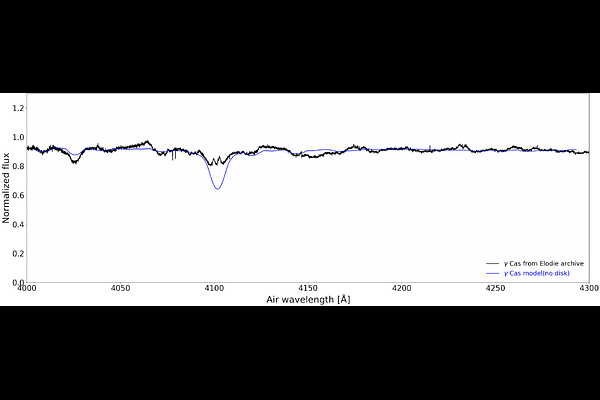Measurement of the photosphere oblateness of $γ$ Cassiopeiae via Stellar Intensity Interferometry with the VERITAS Observatory

Measurement of the photosphere oblateness of $γ$ Cassiopeiae via Stellar Intensity Interferometry with the VERITAS Observatory
A. Archer, J. P. Aufdenberg, P. Bangale, J. T. Bartkoske, W. Benbow, J. H. Buckley, Y. Chen, N. B. Y. Chin, J. L. Christiansen, A. J. Chromey, A. Duerr, M. Escobar Godoy, S. Feldman, Q. Feng, S. Filbert, L. Fortson, A. Furniss, W. Hanlon, O. Hervet, C. E. Hinrichs, J. Holder, Z. Hughes, T. B. Humensky, W. Jin, M. N. Johnson, M. Kertzman, M. Kherlakian, D. Kieda, N. Korzoun, T. LeBohec, M. A. Lisa, M. Lundy, G. Maier, N. Matthews, P. Moriarty, R. Mukherjee, W. Ning, R. A. Ong, A. Pandey, M. Pohl, E. Pueschel, J. Quinn, P. L. Rabinowitz, K. Ragan, P. T. Reynolds, D. Ribeiro, E. Roache, J. G. Rose, I. Sadeh, L. Saha, M. Santander, J. Scott, G. H. Sembroski, R. Shang, D. Tak, J. V. Tucci, J. Valverde, V. V. Vassiliev, D. A. Williams, S. L. Wong, The VERITAS Collaboration
AbstractWe use the stellar intensity interferometry system implemented with the Very Energetic Radiation Imaging Telescope Array System (VERITAS) at Fred Lawrence Whipple Observatory (FLWO) as a light collector to obtain measurements of the rapid rotator star $\gamma$ Cassiopeiae, at a wavelength of 416 nm. Using data from baselines sampling different position angles, we extract the size, oblateness, and projected orientation of the photosphere. Fitting the data with a uniform ellipse model yields a minor-axis angular diameter of $0.43\pm0.02$ mas, a major-to-minor-radius ratio of $1.28\pm0.04$, and a position angle of $116^\circ\pm5^\circ$ for the axis of rotation. A rapidly-rotating stellar atmosphere model that includes limb and gravity darkening describes the data well with a fitted angular diameter of $0.604^{+0.041}_{-0.034}$ mas corresponding to an equatorial radius of 10.9$^{+0.8}_{-0.6}~R_\odot$, a rotational velocity with a $1~\sigma$ lower limit at $97.7\%$ that of breakup velocity, and a position angle of $114.7^{+6.4}_{-5.7}$ degrees. These parameters are consistent with H$\alpha$ line spectroscopy and infrared-wavelength Michelson interferometric measurements of the star's decretion disk. This is the first measurement of an oblate photosphere using intensity interferometry.